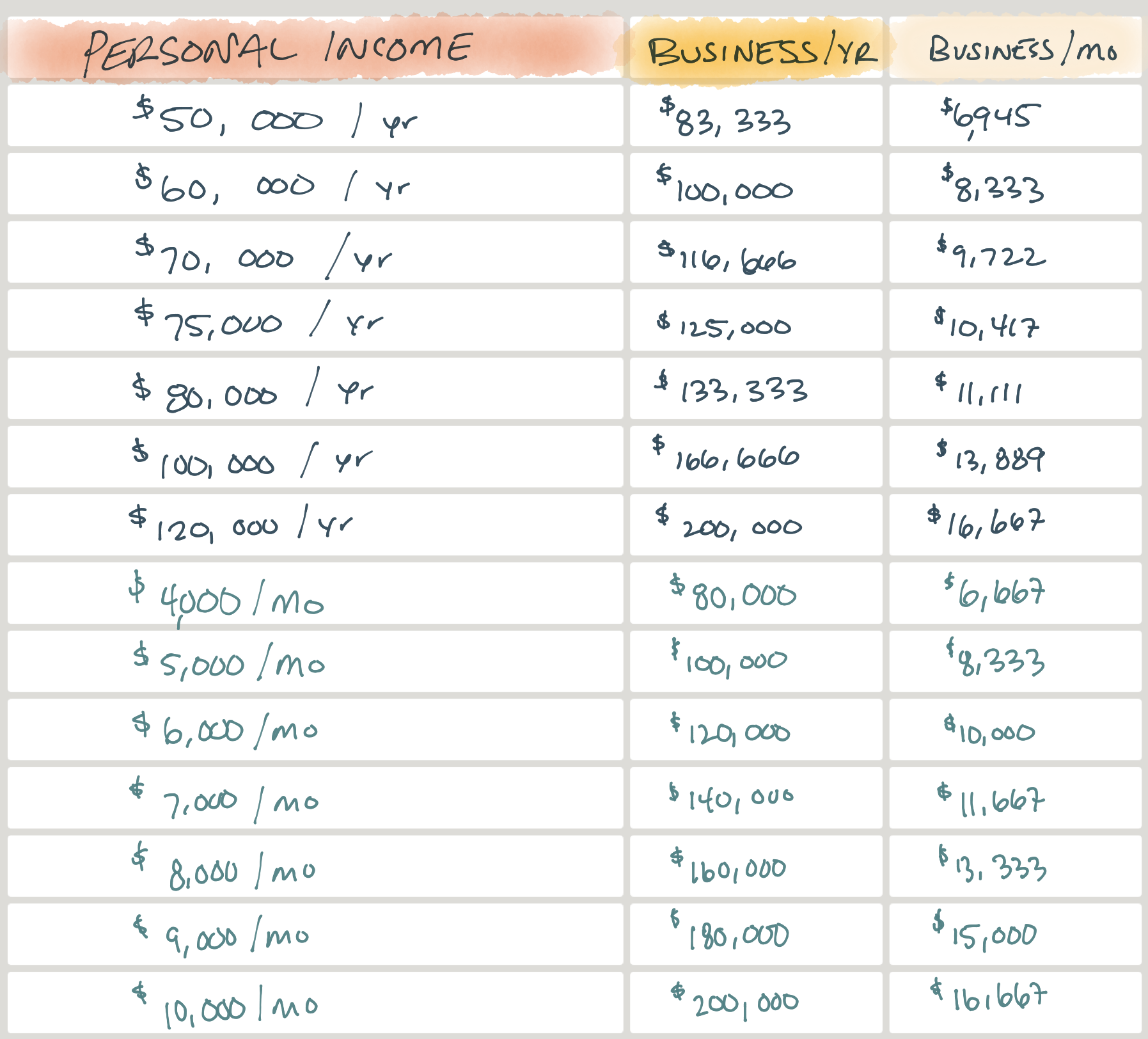Create A Minimum Viable Business

I commend you for making it this far!
In section 1 of the book, we covered the most important part of the process from going from a five-figure creator to a six-figure business owner: mindset.
If you haven't gone through all of the action items in those chapters, you'll lack the necessary foundation for everything that follows about how to master the different areas of your business that we'll cover in the rest of the book.
Now, with that out of the way, it's time to dive in and build our six-figure business.
We start with: Finances!
I can hear your excitement from all the way over in Provo, Utah where I live!
The reason we start here is that without a firm financial structure in place, everything else that follows may succeed in the short term, but not long term.
Just as a house needs a solid foundation, we have our mindset. Then we add the framing - the structure - which is our business' finances.
Then we'll add everything else - marketing, audience building, sales, and systems.
Let's start with understanding the Minimum Viable Business and how you can create one instantly just by understanding some key metrics and numbers.
Yay! Numbers!
Remember, every business needs a Manager at times, and you're going to step into that Manager persona for this and many of the upcoming chapters.
Defining a Minimum Viable Business
Here's how I want you to look at your business:
What is the smallest amount of customers, projects, and revenue that you need for the business to be viable?
Knowing this allows you to know when you have a viable business, and then, using the following chapters in the book, how to grow the business from there.
You don't want to grow a business that isn't viable. That would be like making more lasagne with spoiled ground beef. More isn't better, more is objectively worse.
The Ingredients of a Minimum Viable Business
Every business needs these three things:
- A customer or client
- A product or service
- An offer that produces revenue for the business
That's it.
Some businesses have a single customer or client. That single client purchases enough of the product or service to generate revenue that covers the cost of doing business, making the business viable.
Other businesses operate by selling to many customers one time or very infrequently. They may have lower-priced products, but still are able to sell enough volume to have the revenue they need to make the business viable.
On the other hand, when one of the three items is lacking, the business becomes unviable.
(Yes, unviable is a word. I looked it up.)
Without enough customers, a business can't survive.
Without a valuable product or service, the business can't convince any amount of customers to buy.
Without an offer that generates revenue, it doesn't matter how good the product or how large the customer base, it won't lead to any revenue, and the business will fail.
You need all three at a minimum viable amount in order for the business to succeed.
Step 1 - Determine How Much Your Business Needs To Make
In order to understand what your "MVB" looks like, I have to make a few assumptions.
I'm assuming you either have a product or service that you currently sell, or that you know what you want to sell to your customers and clients.
If you don't yet know what you want to sell, that's, unfortunately, outside of the scope of this book, but you can look at some of the other resources on CraftsmanCreative.co for more information.
Now, get out a clean note page or open a new document, because we're about to get busy with some numbers!
(If you have resisted stepping into the Manager persona, do that now!)
You'll work backward from whatever your minimum viable income is for your business, and you'll determine that using this formula:
Your Personal Income ÷ 0.6
Why 0.6? Because, generally speaking, you want to have at least 40% of your business income set aside for Taxes (15%), Profit (10%), and Operating Expenses (15%).
If you know exactly how much you set aside for taxes, profit, and OpEx, then you can use a different number than 0.6, but for now, it's a good starting point.
So, if you want to pay yourself $5,000 per month, then divide by 0.6 and you'll get $8,333.
Said another way, if your business makes $100,000 per year, it can pay you $60,000 per year.
Here are some other examples that you can pull from if you don't want to do the math:

If you're shocked by this, GOOD! I want you to understand how important and real these numbers are. While your exact situation may vary by a few hundred or even a thousand dollars, this chart might reveal that you were tens of thousands of dollars off in the way you were looking at your business.
If you don't start with the proper numbers, everything else gets messed up down the line.
One last note, these numbers represent your business's net income or "real revenue".
If you sell a service that costs you $100 to provide, and you sell it for $200, your "net income" or "real revenue" is $100. We aren't accounting for the cost of goods sold or the cost to provide the service in these numbers.
A photographer who charges $1,000 for a wedding but has $300 in film development costs only has a net income of $700 per shoot. That's the number that you should be using when looking at your minimum viable income, not the total or "gross income" numbers.
With your business, step one is to determine how much you want/need to pay yourself and how much your business needs to make in order to pay yourself that amount.
Keep in mind that if you have business partners or employees, you need to double or add to the initial number that you want to pay yourself.
With that number in hand for your business, you can move to step two!
Step 2 - Determine Your Minimum Viable Sales Number
It's time to look closer at your business.
What is it that you sell?
Do you have a single product or many?
A combination of products and services? Or one or the other?
What we're after is a number - how much money does a typical customer spend when they buy from or hire you?
If you are a graphic designer who charges, on average, $2,500 per project, then your number is $2,500.
If you are a musician who gets $1,000 per day in the studio, $250 per live show, and $5 per album that you sell, then you have three numbers. You can either average them out ($418.33) or do this exercise for all three (recommended).
This number is known as your average order value or AOV. When you multiply that number by the average amount that you sell each month, that leads you to your gross revenue.
Those two numbers should be the same!
So, to figure this out, look at your business for the last three months. If you have Quickbooks or similar accounting software you can use that, or you can use whatever software you use to sell your products or produce invoices.
Looking at the last three months, add up every single project and every single sale of your product.
Total the amount of money made from the projects or services, and divide by the number you sold.
If you sold a total of $25,000 over 10 projects, then your number would be $2,500.
If you sold 100 products for a total of $12,500, then your average would be $12.50.
Then we take one last step.
Take this AOV number ($2,500 or $12.50 in our examples) for your business, and divide it by your monthly net income number from step one.
If you need to make $15,000 a month, and your AOV is $2,500, then your minimum viable sales number is six.
Net Revenue ÷ AOV = Minimum Viable Sales Number
($15,000 ÷ $2,500 = 6)
Now you know with absolute clarity how many projects you need per month in order to have a minimum viable business.
I emphasize viable because plenty of freelancers and contractors run their business just below that viable number.
If they need six projects a month to be viable, they often only have three to five, and so they live paycheck to paycheck and fail to grow past that point.
The reason is that their business isn't structured to deliver more than 4 projects a month.
Read that again.
If they need six projects to be viable, but only have the ability to produce and deliver four, then they'll never have a viable business because their business was set up to prevent that from the start!
To prevent this, you need to take the third step and create a minimum viable offer based on these numbers from step one and step two.
Step 3 - Create A Minimum Viable Offer
To be clear, the offer leads to revenue for your business, it's the vehicle that brings in cash flow that provides the much-needed oxygen your business needs to survive and thrive.
Without a viable offer, you won't have any sales. Period.
How do you know when you have a minimum viable offer? When you make enough money per sale and sell enough of your offer to create a minimum viable business.
Said differently, a minimum viable offer connects the pieces we've already uncovered in steps one and two and makes it all work.
Going back to our graphic designer example, her current business sells graphic design services for an AOV of $2,500 and can do four projects per month.
We found that this is not a viable offer, because she is unable to meet her minimum viable business revenue number of $15,000 per month.
She has three options (that are also applicable to you if you're in the same situation)
- Increase her price per project to $3,750 ($3,750 x 4 = $15,000)
- Increase the number of projects she can do per month ($2,500 x 6 = $15,000)
- Add more products or services to her business
Depending on her situation, options 1 and 2 may not be feasible right now, and she needs a quick change to her business to make it viable as soon as possible.
She could, in theory, take a few days to create a product that she could sell $5,000/month worth, like an ebook, an online course, or stock graphics.
She could create a smaller, $1,000 service package that can be done in one day instead of five, making more per hour and adding to her total revenue.
However she, or you, decides to evolve the business, the goal is to get to a minimum viable offering for the products and services your business sells.
Until you do this, you have an unviable business, meaning one that is unsustainable and impossible to grow.
If you've ever felt stuck in your business, do the work in this chapter. Step into that Manager persona and let them run your business for a minute so that you can get clarity on what's really going on and identify the one thing you need to work on right now.
Ask yourself: what do I need to do to create a minimum viable business?
Do you know how much your business needs to make?
Do you have a minimum viable sales number? (Are you selling the minimum amount every month? More on that in the marketing and sales sections.)
Do you have a minimum viable offer that will allow your MVB to work?
If you answered no to any of these questions, then tackle them one by one. Do the work and you'll get incredible clarity on the current state of your business, as well as what to do next to take your business to the next level.
The reason that artists get stuck making $30-80k per year is that they never step into the Manager or Entrepreneur persona and look at their business from a different perspective.
Doing this may be hard, but it is a proven process that will help you bridge the gap from a five-figure creator to a six-figure business owner.
But only if you do the work.
So, take all the time you need now, before going to the next chapter, to answer these questions and create a minimum viable business for yourself.
What does your new business look like?
Write it down, as that is your new mission for the next 90 days. You can add it to your mission from part 1, as your goal when you purchased this book is to build a six-figure business and we'll get you on the right track in the following chapters and sections of this book.
NEXT CHAPTER >

< PREVIOUS CHAPTER








Member discussion